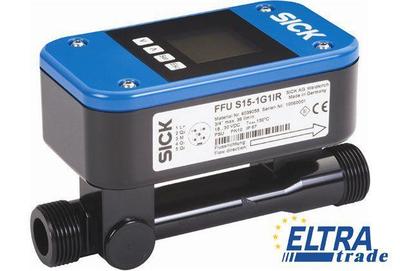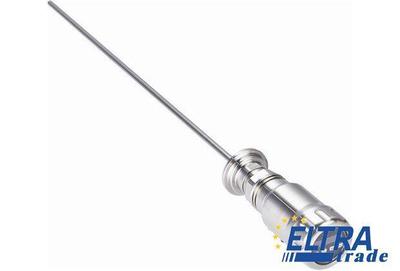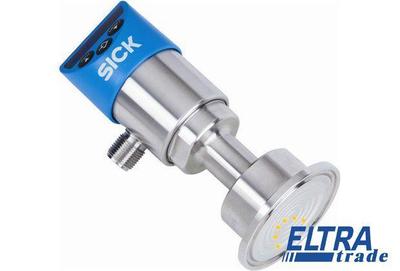Sick Fluid sensors
- Flow sensor for conductive and non-conductive liquids
- Compact design with no moving parts
- Process temperature up to 80 °C, process pressure up to 16 bar
- Flow sensor for conductive and non-conductive liquids
- Compact design with no moving parts
- Process temperature up to 80 °C, process pressure up to 16 bar
- Flow sensor for conductive and non-conductive liquids
- Compact design with no moving parts
- Process temperature up to 80 °C, process pressure up to 16 bar
- Flow sensor for conductive and non-conductive liquids
- Compact design with no moving parts
- Process temperature up to 80 °C, process pressure up to 16 bar
- Flow sensor for conductive and non-conductive liquids
- Compact design with no moving parts
- Process temperature up to 80 °C, process pressure up to 16 bar
- Flow sensor for conductive and non-conductive liquids
- Compact design with no moving parts
- Process temperature up to 80 °C, process pressure up to 16 bar
- Flow sensor for conductive and non-conductive liquids
- Compact design with no moving parts
- Process temperature up to 80 °C, process pressure up to 16 bar
- Flow sensor for conductive and non-conductive liquids
- Compact design with no moving parts
- Process temperature up to 80 °C, process pressure up to 16 bar
- Flow sensor for conductive and non-conductive liquids
- Compact design with no moving parts
- Process temperature up to 80 °C, process pressure up to 16 bar
- Flow sensor for conductive and non-conductive liquids
- Compact design with no moving parts
- Process temperature up to 80 °C, process pressure up to 16 bar
- Flow sensor for conductive and non-conductive liquids
- Compact design with no moving parts
- Process temperature up to 80 °C, process pressure up to 16 bar
- Flow sensor for conductive and non-conductive liquids
- Compact design with no moving parts
- Process temperature up to 80 °C, process pressure up to 16 bar
- Flow sensor for conductive and non-conductive liquids
- Compact design with no moving parts
- Process temperature up to 80 °C, process pressure up to 16 bar
- Level monitoring in hygienic applications
- Manually cutable monoprobe up to 4,000 mm long with Ra lessthan 0.8 µm
- Process temperature up to 180 °C, process pressure up to 16 bar
- Level monitoring in hygienic applications
- Manually cutable monoprobe up to 4,000 mm long with Ra lessthan 0.8 µm
- Process temperature up to 180 °C, process pressure up to 16 bar
- Level monitoring in hygienic applications
- Manually cutable monoprobe up to 4,000 mm long with Ra lessthan 0.8 µm
- Process temperature up to 180 °C, process pressure up to 16 bar
- Level monitoring in hygienic applications
- Manually cutable monoprobe up to 4,000 mm long with Ra lessthan 0.8 µm
- Process temperature up to 180 °C, process pressure up to 16 bar
- Level monitoring in hygienic applications
- Manually cutable monoprobe up to 4,000 mm long with Ra lessthan 0.8 µm
- Process temperature up to 180 °C, process pressure up to 16 bar
- Level monitoring in hygienic applications
- Manually cutable monoprobe up to 4,000 mm long with Ra lessthan 0.8 µm
- Process temperature up to 180 °C, process pressure up to 16 bar
- Level monitoring in hygienic applications
- Manually cutable monoprobe up to 4,000 mm long with Ra lessthan 0.8 µm
- Process temperature up to 180 °C, process pressure up to 16 bar
- Level monitoring in hygienic applications
- Manually cutable monoprobe up to 4,000 mm long with Ra lessthan 0.8 µm
- Process temperature up to 180 °C, process pressure up to 16 bar
- Level monitoring in hygienic applications
- Manually cutable monoprobe up to 4,000 mm long with Ra lessthan 0.8 µm
- Process temperature up to 180 °C, process pressure up to 16 bar
- Level monitoring in hygienic applications
- Manually cutable monoprobe up to 4,000 mm long with Ra lessthan 0.8 µm
- Process temperature up to 180 °C, process pressure up to 16 bar
- Electronic pressure switch for pneumatic applications
- Large display shows system pressure, output states and set switching points
- Three large function keys and intuitive menu navigation
- Measurement ranges from 0 ... 1 bar up to 0 … 25 bar
- No moving parts: No mechanical wear, fatigue-proof, maintenance-free
- Stainless steel membrane
- Hygienically-graded pressure switch with display for the food and beverage industry
- Wetted parts are made from stainless steel 1.4435
- Individually programmable switching outputs and analog output
- Hygienically-graded pressure switch with display for the food and beverage industry
- Wetted parts are made from stainless steel 1.4435
- Individually programmable switching outputs and analog output
- Hygienically-graded pressure switch with display for the food and beverage industry
- Wetted parts are made from stainless steel 1.4435
- Individually programmable switching outputs and analog output
- Hygienically-graded pressure switch with display for the food and beverage industry
- Wetted parts are made from stainless steel 1.4435
- Individually programmable switching outputs and analog output
Growing demands for complex automated processing systems, control, and regulation processes lead to the use of fluid sensors in various industries. These sensors improve level measurement accuracy, reduce chemical process variability, and maintain higher product quality. In addition, liquid sensors help reduce waste and are economical and reliable. Today we will talk about Sick fluid sensors.
What Is a Fluid Sensor?
A fluid sensor is a type of electronic device that evaluates and regulates the circulation or flow rate of liquids and gases in confined spaces such as pipes and tubes. These sensors can also be used to control solids such as powders. Typically, these sensors are connected to sensors to display their measurements. However, fluid sensors can also be connected to computers and digital interfaces to provide results.
Liquid sensors can easily detect leaks, blockages, and pipe breaks, and are also used to change the liquid concentration caused by pollution or pollution. Typically these sensors are used in HVAC systems, medical devices, chemical plants, and households.
Liquid level sensors are designed to control the level of liquids in various tanks. Depending on the type of application where the sensor is used, contact or non-contact measurement methods are used. In contact measurement (float-type sensors), the sensor is located directly on the tank wall and switches contacts when the water reaches the level of its placement. Measurements of the level of liquids and solids can be carried out by various methods: magnetic measurements, capacitive, optical, ultrasonic, etc.
There are three types of fluid sensors.
- Ultrasonic fluid level sensors. In ultrasonic sensors, the main elements are electronic circuits. They generate an ultrasonic pulse that travels through the air in the tank and is reflected back to the sensor from the liquid/air interface. The time during which the reflected signal returns is the main criterion for liquid level measurement. Can be used to determine the water level. fuels and other liquids.
- Liquid-level laser sensors. Laser sensors are not suitable for every liquid. It should only be used for an opaque medium so that it can reflect the laser beam. Its main application is a remote measurement of the medium level. Structurally, this sensor is a laser rangefinder that very accurately shows the liquid level. Can be used to determine the water level. fuels and other liquids.
- Hydrostatic liquid level sensors. A hydrostatic transducer is a device that is placed on the bottom of a tank to measure water pressure. It is directly proportional to its level. The advantage of such a sensor is that it can measure the level of not only clean but also wastewater. Can be used to determine the water level. fuels and other liquids.
Sick offers several types of fluid sensors.
- Fluid level sensors. These instruments are designed to measure the level of water or other liquids. They can operate mechanically, hydrostatically, electrically, magnetically, or optically, or use level gauges with echolocation and radar.
- Fluid pressure sensors. These devices, which have a fairly large range of action, primarily allow you to give accurate measurements of various types of pressure.
- Fluid temperature sensors. These devices are designed to measure the temperature of the liquid in the tank.
- Fluid flow sensors. These devices are designed to measure oil, oil products, water, their mixtures, liquefied gases, and other liquids in technological processes in the oil-producing, and oil-refining industries, as well as in industrial enterprises and public utilities.
Applications of Sick Fluid Sensors
Due to the growing need for automation and digitalization, liquid sensors have recently found many applications.
- Liquid sensors are widely used in the automotive industry, such as in automobiles. In automobiles, these sensors are used to monitor the level of fuel, oil, and sometimes power steering fluid.
- These sensors are also used to control secondary air injection, exhaust gas recirculation, engine management, etc. in vehicles.
- In addition, these sensors are also used in automotive HVAC systems, fuel cells, and car electronic immobilizers.
- Liquid sensors are mainly used in the oil and gas industry, but also in some industries such as chemical plants, the pulp and paper industry. In addition, there is a growing demand for multi-phase sensors, especially in the gas and oil industry.
- When considered in the manufacturing industry, liquid sensors have a wide segment of applications in this sector. These industries include food processing, mining, energy, and power plants that need sensors to improve productivity.
- There are many uses for fluid sensors in the medical sector. These sensors are used in medical processes such as respiratory applications, blood flow maintenance, anesthesia machines, continuous monitoring of patient gas flow and volume during mechanical ventilation, etc.
Maintenance and Troubleshooting
When a failure occurs, the increase in downtime often results in lost productivity. Sick provides fast and easy assistance with its worldwide service network. The company's technicians arrive on site within a short period of time to quickly and reliably fix the problem and minimize downtime. Each customer also receives detailed service reports and advice on how to prevent future outages.
If you want to choose the devices that are right for you, we recommend that you first read the Sick fluid sensors manual. Thus, you can quickly and clearly understand what kind of equipment you need.





























